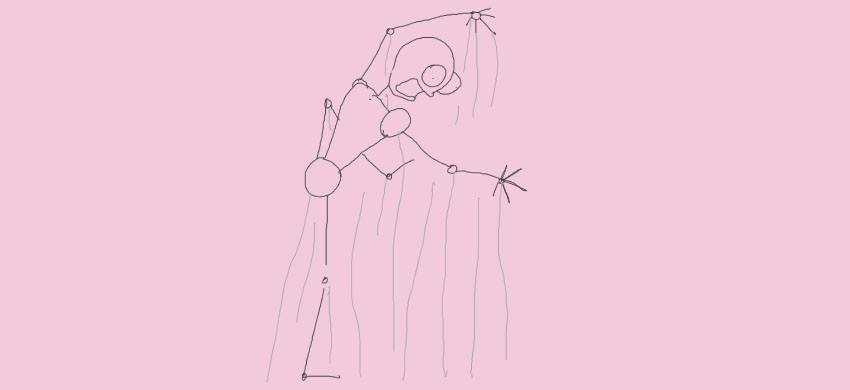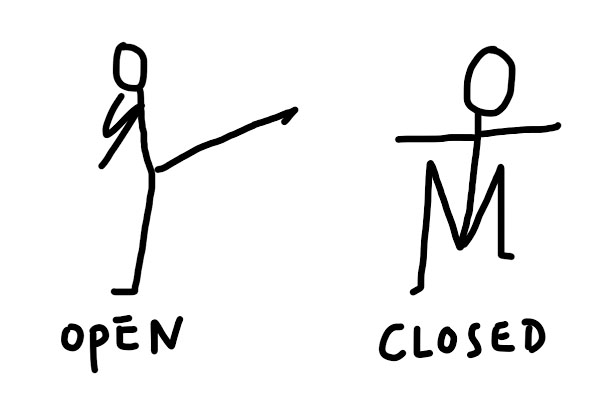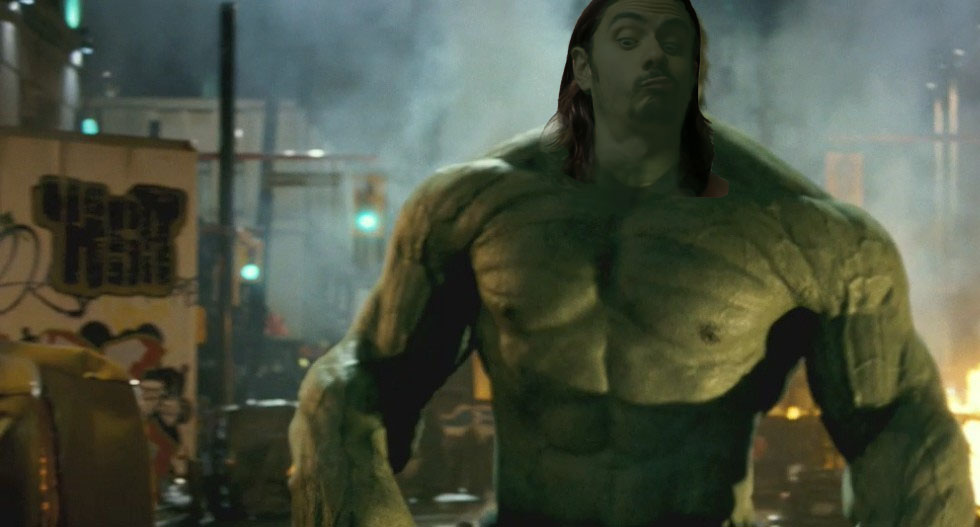If you want to build muscle, you need to convince your body that it needs muscle. I established this mindset in Part 1. You don’t realize it, but you’ve already convinced your body to build muscle because, uhh, you do have muscle. Maybe not as much as you’d like to have. But you most certainly have some. Look at [...]
If you want to build muscle, you need to convince your body that it needs muscle. I established this mindset in Part 1.
You don’t realize it, but you’ve already convinced your body to build muscle because, uhh, you do have muscle. Maybe not as much as you’d like to have. But you most certainly have some.
Look at you. You don’t even know how to get more of something you already have. So helpless. Don’t worry. I’m here to light the way. On fire. So we all die. Sounds fun. I’m in. Let’s go.
If you want to convince your body to build more muscle, it helps to know what purpose muscle mass serves. Why you have it. How you (unconsciously) convinced your body to build it.
I like approaching this puzzle from the upside down.
Meaning, right now, you’re focused on building more muscle. Everything is in relation to more morE moRE mORE MORE MOAR. But a lot of things fall into place when you focus on losing muscle.
Like I said: the upside down.
How to lose a muscle in ten days
Set aside your desire to build muscle, and look first at what it takes to lose muscle.
Gertrude in hospice care is whiz cheese. An astronaut living in space melts like fondue. You break your wrist, get put in a cast, and your forearm turns into a toothpick.
Hmm…
There’s a common theme: moving your body parts through Earth’s gravity.
- It’s not just gravity.
- It’s not just moving your parts.
It’s both.
There’s a good chance, at this point, everything you need to know tetrised together inside of your brain. Muscle makes sense now. You don’t have to read anymore. Good luck. See ya later. Glad to be of service.
But I’m a nerd. I over intellectualize. Care to join me? You’re invited. As long as you don’t complain about how weird we get.
Angry sexually provocative women
Gravity is important, but its easy to ignore. It’s an afterthought, like water to a fish. I wouldn’t know for sure though, my meeting with Princess Ruto inside of Jabu-Jabu’s belly was cancelled.

To avoid the gravitational ignorance, let’s give gravity a face. A mean one. An Andross one. I hope it doesn’t spit three dimensional floor tiles at us.
If you go in a zero gravity chamber, you float. Right? Not rocket science. Just kidding. Zero gravity chambers are all sorts of rocket science.
But now, imagine, as you’re floating in the zero gravity chamber, a bunch of women wearing white lab coats enter the zero gravity chamber.
They’re wearing special gravity suits, so they don’t float. They use special gravity ropes to lasso you out of the air. The situation intrigues you for a moment, from a sexual standpoint. But that intrigue sprinkles into sadness when they start drilling holes into every single one of your bones.
They loop special gravitational ropes through the holes. They connect the special gravitational ropes to the special gravitational floor.

Once the ropes are connected to the floor, they’re given a certain amount of downward pull — the degree of which depends on the mass of the bone attached to the rope.
Your hand is a dumbbell, dawg
The downward pull of the ropes is a product of gravity and mass. Combined, this gives birth to the much more familiar concept of “weight.”
Now, it’s important to remember that “weight” is a function of Earth’s gravity. If you went to Jupiter, where gravity over double Earth’s, you’d weigh more. This is important. I’ll come back to this in a little bit.
For now, we have to go micro. Forget about total body weight and look more at body part weight.
It’s strange to think of of your body parts as “weight,” but they are. Let’s pretend your hand (by itself) weighs five pounds. Or something. I don’t know how much a hand weighs.
If you chop off your hand at the wrist, when it falls to the ground, it’s nothing but a five pound dumbbell. Now take that same hand (the one disconnected from your body) and chop off a finger. It’ll weigh less because the finger, too, has weight. And now it’s gone. Like my sanity.
You move yer parts
You’re this slimy moist machine thingy that’s been endowed with voluntary movement. My coffee mug hasn’t gone anywhere since I started typing this.
The gravitational ropes staple the coffee mug to the table. If you weren’t able to move, the same thing would happen to you. You’d be a lifeless waffle on the floor.
But you can move. And, in order for you to move, the body parts powering your movements must be able to lift and control the weight of your (other) parts.
Here’s an example using your formerly severed hand, which is now soldered back onto your wrist. In order for you to wiggle and move your hand, your forearm has to be strong enough to able to “lift” the weight of your hand.
Imagine if your hand (just your hand) weighed ninety pounds more than it does right now. Would you be able to move it? Probably not. Because your forearm isn’t strong enough to move that amount of weight. The downward force of gravity is too much for you to overcome. You are a lifeless pancake.
You’re lifting weights EVERY DAY BRO
You’re always lifting “weights” because your body parts are weights. You take this reality for granted because you tend to be strong enough to move the weight of your body parts.
So in order to appreciate this, it helps to decode the “weight” responsibility for any given movement. It’s an easy thing to do if you know a thing or two about anatomy. (Joints and bones are the breadcrumbs leading you to answers.)
Open kinetic chain movement
During an open kinetic chain movement, your moving parts are free to wiggle through space. Think of side kicking a little person, or punching someone in the tooth.
Open kinetic chain movements tend to flow from the center to the extremities.
If you bend at the elbow and do a biceps curl, the structures enabling the movement have to be strong enough to lift everything down the chain: the weight of the forearm, the weight of the hand, and the weight of the fingers.
If you lift your knee in the air, the structures enabling the movement have to be strong enough to lift the weight of the thigh, the weight of the lower leg, the weight of the foot, and the weight of the toes.
Closed kinetic chain movement
During a closed kinetic chain movement, your moving parts are anchored. Think of doing a bodyweight squat to poop in a hole, or during a push-up (sans awful context).
Closed kinetic chain movements tend to flow from extremities to the center.
If you do a bodyweight squat, your legs have to be strong enough to lift the weight of your torso, the weight of your arms, and the weight of your head.
If you do a handstand push-up, your arms have to be strong enough to lift the weight of your torso, the weight of your head, and the weight of your lower body.

Introducing: load (terrible word)
I’ve been using the word “weight,” but “weight” is confusing. The word is used too frequently in other contexts. It’s easier to think in terms of “load.” (I’m sure I could have dug up a word less porn than “load,” but there’s no turning back now.)
“Load” is the weight of your body parts in addition to the weight of external objects.
LOAD
=
(WEIGHT OF BODY PARTS)
+
(WEIGHT OF EXTERNAL OBJECTS)
Right now, we’re focusing on the weight of your body parts and neglecting external object half. But establishing the concept of “load” is important because it’s easily underappreciated.
The importance of load
If you do a side kick, the load is: your leg from the hip down. If you do a bodyweight squat, the load is: your entire upper body. The squat load is much bigger. And not because you have a giant head (even though you might).
Likewise, look at the load of throwing a punch: your arm from the shoulder down. Compare to a handstand push-up load: your head, torso, and your lower body. The handstand push-up load is much bigger. And not because you have a giant penis or huge boobs (even though you might).
Even though these are all “bodyweight” movements, the load varies considerably. This also connects to weighted exercises.
Think of, say, a dumbbell curl. You’re doing curls with five pounds in each hand. You’re lifting five pounds. Now imagine doing chin-ups with a five pound dumbbell attached to your waist. You’re once again lifting five pounds.
Its easy to get confused and say you’re lifting the same amount of weight during both exercises (five pounds), but this isn’t true because you’re neglecting the other half of load.
The chin-up exposes your body to a much higher load than the curl does, even though the same amount of external weight is present.
The muscle trigger
Load is muy importante for reasons that’ll come into focus a little later. For now, I’m going to ignore as if I never went on the diatribe. I implore you to do the same.
You’re lifting and controlling the weight of your parts all day long. Or, otherwise said, you’re constantly yanking on the gravity ropes that are trying to stapling you to the ground.
This is why you have muscle mass.
This is the <NEED> “trigger.” Muscle mass helps your body move and overcome the downward pull of gravity’s ropes. By regularly moving and overcome said pull, you tell your body: “Psssst. Hey. You know these muscle things? They’re kind of important. I need them.”
It’s like this…
Why is money so important? Because you use it. All the time. Using money tells your dumb brain, “This is important. I need it.”
Likewise, if you no longer move and overcome gravity’s ropes, you aren’t pulling the <NEED> trigger. So your body gets rid of muscle mass.
Makes sense. As mentioned, in Part 1, your body has a gollumness towards energy. If muscle helps you move and overcome gravity and you aren’t moving and overcoming gravity, then spending precious energy to keep it around is a waste. And you know how your body feels about waste.
Why don’t you look like Hulk?
Overcoming gravity is the trigger. To which you might now be wondering: Why do I only have the muscle that I have? I move. I “overcome.” Why don’t I keep growing muscle? Why don’t I look like the Hulk?

Because there are bottlenecks in both directions. First, gravity never changes. It’s always nine point something or other squared dragging you down. Second, the mass of your body parts don’t really change, either. Your hand is always five pounds.
So your body builds enough muscle to enable you to move and overcome this load. Building more than what’s necessary isn’t energy efficient.
So how do you build more muscle?
PUZZLE TIME!
- No gravity = fondue
- Gravity = meh muscle
- ______ = MOAR muscle
Fill in teh blankz112!!12121121 PUZLES! I WIKE PUZZLEWJEBWedfhj. farts.
How to create your own hyperbolic time chamber using toilet paper rolls

Unfortunately, there’s no hyperbolic time chamber. And you can’t fly to Jupiter. You can’t enter a supergravity world. You have to increase the effect of Earth’s gravity by adding mass to your body parts. Or, using lingo you’re now privy to: you need to make your body move more load than its used to moving.
There are three ways to do this.
First, do something with more of your bodyweight involved that you’re not used to doing. An example: doing chin-ups for the first time.
Second, do something with one limb that you normally do with two limbs. An example: doing one-arm chin-ups for the first time.
Third, add an external weight to a part (or parts) of your body during a movement you’ve already mastered with your bodyweight. An example: doing weighted chin-ups for the first time.
A =note to preserve my sanity JUST KIDDING ITS GONE LOlloloLloL
There are a bunch of different ways to add an external weight to your body. When you hold a soup can, you’re adding an external weight to your body. When you lift a couch while helping your friend move, you’re adding an external weight to your body.
Just about any form of resistance training adds “weight” even if its not actually “weight” (like resistance bands). It may be better to think of “weight” as simply ” external resistance of any sort” for now because, for the time being, I’m going to remain agnostic about how external weight (resistance) is added.
But, later, I won’t.
Because I’m just that kind of guy.
How much weight?
Things are coming together. Gravity staples things with mass to the floor. Humans are gross moist things equipped with voluntary movement, which allows them to give gravity the middle finger.
Giving gravity the middle finger requires muscle, yet, at the same time, it is the trigger for building muscle. There’s something about this that doesn’t make sense, but I’m already drowning in cesspool of cognition.
If you want to build more muscle, you have to throw yourself into a supergravity world. The question is: how “supergravity” do you have to go? Like, if I, like, duct tape a five pound dumbbell to my hand, like, will I, like, get jacked?
→ Click here to read Part 3: How much WEIGHT do you have to LIFT in order to BUILD muscle?
P.S.
When looking at situations that cause muscle loss, I could have mentioned prisoners of war. Starving isn’t good for muscle. But, as mentioned in Part 1, I’m not focusing on <FEED> in this guide.